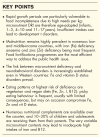Micronutrient deficiency and supplements in schoolchildren and teenagers
- PMID: 38462972
- PMCID: PMC11864051
- DOI: 10.1097/MCO.0000000000001027
Micronutrient deficiency and supplements in schoolchildren and teenagers
Abstract
Purpose of review: The essential micronutrients are corner stones in the functional and physical development. Early deficiency has life-long consequences. While awareness about iron deficiency is relatively high, it remains lower for other micronutrients. This review aims at reporting on recent data and attracting attention to the high prevalence of micronutrient deficiencies in school-age and adolescent individuals.
Recent findings: Iron deficiency anaemia remains highly prevalent worldwide and the most frequent deficiency but can be corrected with simple tools ranging from food fortification, nutritional intervention, and to supplements. The link between micronutrient (MN) deficiency and neurobehavioral disorders is increasingly established and is worrying even in Western countries. Paediatric individuals are prone to imbalanced diets and picky eating behaviour, and their diets may then become incomplete: the highest risk for deficiency is observed for iron, zinc and vitamin D.
Summary: There is not much new information, but rather confirmation of the importance of health policies. Well conducted randomized controlled trials confirm that deficiencies can be corrected efficiently including with food fortification, and result in clinical benefits. Individual complementation should be considered in children and adolescents with proven deficiency.
Copyright © 2024 Wolters Kluwer Health, Inc. All rights reserved.
Conflict of interest statement
Similar articles
-
Multiple micronutrient powders for home (point-of-use) fortification of foods in pregnant women.Cochrane Database Syst Rev. 2015 Jun 19;2015(6):CD011158. doi: 10.1002/14651858.CD011158.pub2. Cochrane Database Syst Rev. 2015. PMID: 26091836 Free PMC article.
-
Home fortification of foods with multiple micronutrient powders for health and nutrition in children under two years of age.Cochrane Database Syst Rev. 2011 Sep 7;(9):CD008959. doi: 10.1002/14651858.CD008959.pub2. Cochrane Database Syst Rev. 2011. Update in: Cochrane Database Syst Rev. 2020 Feb 28;2:CD008959. doi: 10.1002/14651858.CD008959.pub3. PMID: 21901727 Updated.
-
Nutrition-specific interventions for preventing and controlling anaemia throughout the life cycle: an overview of systematic reviews.Cochrane Database Syst Rev. 2021 Sep 26;9(9):CD013092. doi: 10.1002/14651858.CD013092.pub2. Cochrane Database Syst Rev. 2021. PMID: 34564844 Free PMC article.
-
Fortification of salt with iron and iodine versus fortification of salt with iodine alone for improving iron and iodine status.Cochrane Database Syst Rev. 2022 Apr 21;4(4):CD013463. doi: 10.1002/14651858.CD013463.pub2. Cochrane Database Syst Rev. 2022. PMID: 35446435 Free PMC article.
-
Point-of-use fortification of foods with micronutrient powders containing iron in children of preschool and school-age.Cochrane Database Syst Rev. 2017 Nov 23;11(11):CD009666. doi: 10.1002/14651858.CD009666.pub2. Cochrane Database Syst Rev. 2017. PMID: 29168569 Free PMC article.
References
-
- Requirements Institute of Medicine (IOM). Child and Adult Care Food Program: Aligning Dietary Guidance for All. Washington (DC): National Academies Press (US); 2011. - PubMed
-
- EFSA. Overview on Dietary Reference Values for the EU population as derived by the EFSA Panel on Dietetic Products, Nutrition and Allergies (NDA). EFSA journal 2017. https://www.efsa.europa.eu/sites/default/files/assets/DRV_Summary_tables....
-
- World, Health, Organisation, WHO. Multiple micronutrient powders for point-of-use fortification of foods consumed by children 2–12 years of age. Geneva: WHO; Licence: CC BY-NC-SA 3.0 IGO; 2016.
Publication types
MeSH terms
Substances
LinkOut - more resources
Full Text Sources
Research Materials


